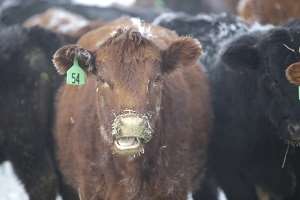By Anna King
Low temperatures, snow drifts and northeasterly winds east of the Cascades are making things difficult for Northwest ranchers and dairy owners. They are struggling to keep their animals hydrated, fed and warm.

Jack Field of Yakima, Washington, said his beef cattle and calves are struggling through 2-foot snow drifts, and his tractors are seizing up in the cold. Keeping the cattle fed is important since they can’t reach the standing hay or the grass under the snow.
Near Othello, Washington, Tony Freeman has 400 milking Holsteins. He said in this cold, every job takes twice as long. Freeman said it’s tough to keep the ice out of water troughs, tractors running, clean bedding and enough feed for the milkers.
Cold is also hard on the humans who tend them. Freeman spends a lot of his time telling his workers to come in the milk parlor every 15 minutes to thaw.
Click here to see more...